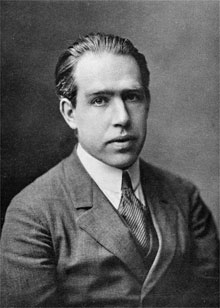
Bohr
Niels Henrik David Bohr (7 October 1885 – 18 November 1962) was a founding father of quantum mechanics and the most important figure in early attempts to interpret the theory. He was the first to introduce the concept of a discrete structure to electron energy levels within the atom, and was able, on this basis, to successfully predict spectral emission and absorption frequencies of the Hydrogen atom. This, together with the theory of specific heats, due to Einstein, Planck’s theory of black-body radiation, and Sommerfeld’s generalization of the quantization rules to any simply-harmonic Hamiltonian system, constituted the ‘old’ quantum theory. The Bohr model of the atom was devised in 1911; its extension to arbitrary multi-periodic systems, and the recovery of the classical Hamiltonian equation for electromagnetic emission in the limit of large quantum numbers, was made in 1922. Bohr’s collaboration with his student Kramers at this time played a pivotal role in Heisenberg’s discovery of the matrix mechanics in 1925.
Bohr was greatly impressed with Heisenberg’s uncertainty relations, and based his theory of complementarity upon them. According to this theory, whenever the use of a scientific concept excluded, in principle, the application of another, there was the possibility of a novel extension of classical ideas and novel phenomena that would otherwise be impossible. In quantum mechanics, such relations of mutual exclusivity were codified by the uncertainty relations. Bohr was optimistic that other examples of mutual exclusivity (‘complementarity’) of classical concepts could be found in other disciplines, notably the life sciences. In this he was disappointed. His debates with Einstein over the interpretation of quantum mechanics concerned the internal consistency of the interpretation of quantum phenomena using classical concepts constrained by the concept of ‘minimal disturbance’ (because of the existence of the ‘quantum of action’, Planck’s constant) and the uncertainty relations. In this he was more successful.
In ensuing decades Bohr’s insistence on the fundamental status of classical concepts fell out of favour, but other aspects of his interpretation of quantum mechanics, notably its broadly operational outlook and its insistence on taking into account the experimental context of any quantum phenomenon, remained influential. But as popularised by Heisenberg in the 1950s, the ‘Copenhagen interpretation’, as Heisenberg called it, involved consideration of ‘the observer’, rather than the experimental apparatus described in classical terms. In special relativity the idea of observer-dependence was frequently used as shorthand for relations to material frames of reference. The idea of the observer-dependence of quantum mechanical effects became a commonplace in the second half of the 20th century, and remains widespread to this day. Reliance on the concept of 'the observer' in the definition of the theory is an aspect of the measurement problem of quantum mechancis.
Bohr also made contributions to nuclear physics and, in chemistry, to the periodic table, predicting the existence and chemical properties of haffniung. In collaboration with Leon Rosenberg in 1932 he also contributed to the early development of quantum field theory. He was awarded the Nobel Prize in physics in1922.
Bohr was born in Copenhagen, where he took his degree in physics. He also studied philosophy under Harald Høffding, a friend of his father. In 1911 he visited the Cavendish Laboratory in Cambridge and, shortly after, took up a post-doctoral position under Ernst Rutherford at Manchester. He eventually returned to Copenhagen to a chair in Theoretical Physics; in 1918 he became director of the new Institute for Theoretical Physics, eventually renamed the Niels Bohr Institute. Virtually all the younger generation of quantum physicists made extended visits to the Institute, among them Dirac and Heisenberg.
Links
Stanford Encyclopedia of Philosophy >
